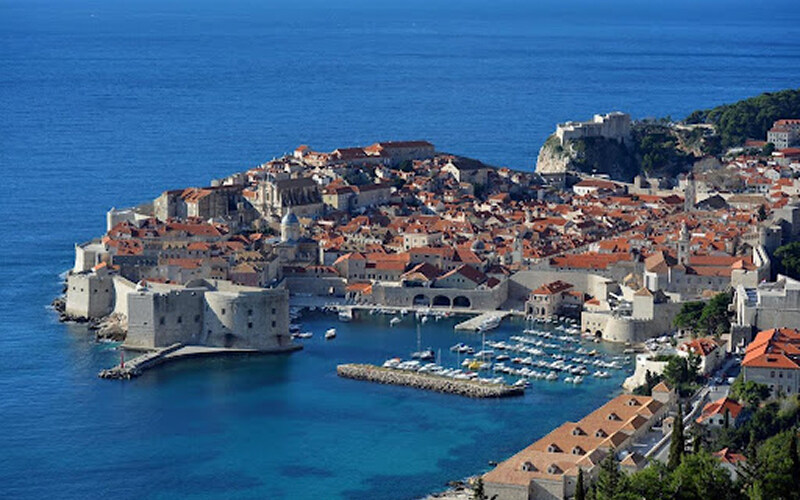Perched on the edge of the Adriatic Sea, Dubrovnik is a Croatian gem where medieval walls, sun-kissed stone streets, and azure waters collide. While it’s famous for its Old Town and as a filming location for Game of Thrones, Dubrovnik also boasts a rich and often-overlooked culinary tradition rooted in Dalmatian coastal flavours, centuries of maritime trade, and a mix of Mediterranean and Slavic influences.
As we’ll see in this article, exploring this stunning city means not only taking in the views – but tasting the past through every plate.
Seafood at the heart of the table
Dubrovnik’s coastal location means seafood is a staple in everyday cooking. Fishermen still bring in the catch of the day each morning, and the freshness is evident in everything from simple grilled fish to more elaborate seafood stews.
- Grilled Adriatic Fish (often sea bass, gilthead bream, or mackerel) is typically served with Swiss chard and boiled potatoes; unfussy, fresh, and full of ocean flavour.
- Black Risotto (Crni rižot) is a deeply savoury dish made with cuttlefish or squid, cooked in its own ink, olive oil, garlic, and white wine. It’s rich, briny, and deeply satisfying.
Pašticada: a celebration dish
Hailing from Dalmatia but loved in Dubrovnik, Pašticada is a marinated beef stew that takes days to prepare. The beef is slow-cooked in a sauce of red wine, prunes, onions, and spices until melt-in-your-mouth tender. Served with gnocchi or fresh pasta, it’s a dish reserved for special occasions – and one that showcases the region’s love of hearty, soulful food.
Pršut and cheese: Dalmatian tapas
A classic starter at any Dubrovnik meal is a plate of Dalmatian pršut (dry-cured ham) served with Paški sir, a salty sheep’s milk cheese from the island of Pag. Drizzled with local olive oil and paired with olives or figs, it’s a savoury-sweet introduction to the region’s coastal bounty. Wash it down with a glass of Plavac Mali, the bold red wine native to the Dalmatian coast.
Zelena Menestra: Dubrovnik’s hearty hidden gem
This centuries-old dish, Zelena menestra (Green Stew), combines smoked meats like ham hocks and sausage with hearty vegetables – mostly cabbage, kale, and potatoes. Traditionally served in the winter, it’s warming, earthy, and reflective of Dubrovnik’s inland influences.
Sweets and surprises
Dubrovnik’s desserts speak to its Venetian past and Mediterranean flair. Rozata is the city’s signature dessert; a silky caramel custard similar to crème brûlée or flan, flavoured with rose liqueur for a floral touch. Meanwhile, arancini are candied orange peels, a simple but addictive local treat that showcases the citrus heritage of the Dalmatian coast. You’ll also find fritule (mini fried dough balls) and padišpanj (sponge cake), often sold at bakeries and markets.
Local wines and olive oils
Dubrovnik isn’t just about food; its wines and olive oils are an essential part of the experience. Nearby Pelješac Peninsula is known for robust reds, especially Dingač, while Malvasija Dubrovacka, a white varietal with ancient roots, is being revived by passionate local winemakers. Elsewhere, olive oil tastings, often included in food tours, introduce travellers to the peppery, golden oils that enhance nearly every dish.
Where to dine in style – or on the street
- Fine dining: 360 Dubrovnik, a Michelin-starred restaurant in the city walls, combines traditional ingredients with haute cuisine.
- Casual & authentic: Barba, a beloved hole-in-the-wall seafood joint, serves octopus burgers and anchovy sandwiches.
- Street food: Grab a burek (savoury pastry stuffed with cheese or meat) from a local bakery and enjoy it while walking along the limestone streets of Old Town.
Dubrovnik’s culinary scene is a reflection of its layered history: Roman, Venetian, Ottoman, and Slavic influences all appear on the plate. Whether you’re tucking into squid-ink risotto by the sea or dipping fresh bread into local olive oil in a konoba (tavern), every dish tells a story of resilience, tradition, and the city’s deep connection to land and sea.
So, when you next visit Dubrovnik, go beyond the walls and castles. Sit down. Take a bite. Taste the legacy.

